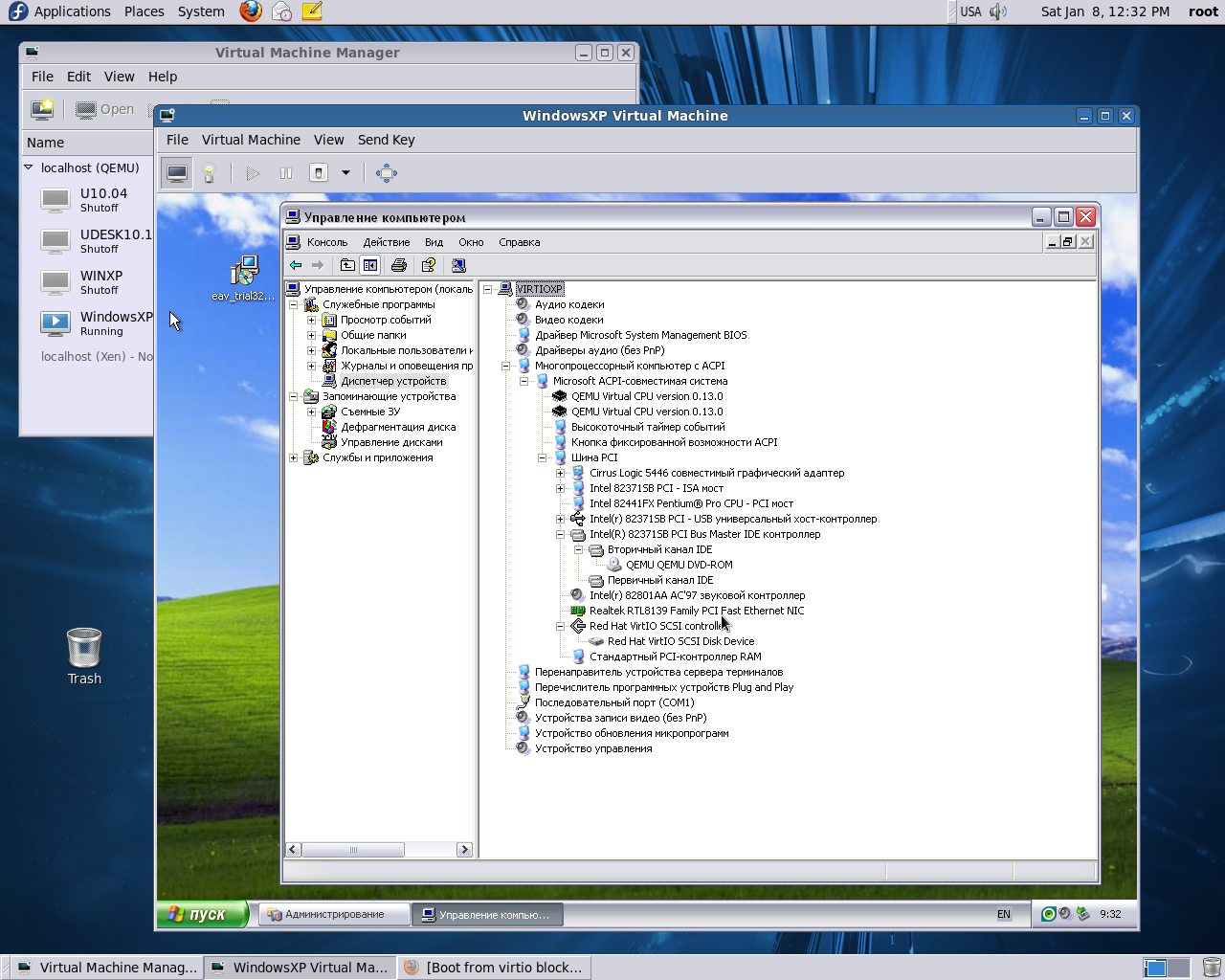Gentoo: emerge -ask app-emulation/qemu. RHEL/CentOS: yum install qemu-kvm. SUSE: zypper install qemu. QEMU can be installed from Homebrew: brew install qemu. QEMU can be installed from MacPorts: sudo port install qemu. QEMU requires Mac OS X 10.5 or later, but it is recommended to use Mac OS X 10.7 or later. QEMU on OS X (macOS) hosts. While QEMU's main host platform is Linux, it is also supported on operating systems for Apple's Mac computers (known as OS X or macOS).The official support policy covers the last two released versions of OSX; QEMU might work on older versions, but it is not guaranteed and it might not even compile on older versions. Cirrus Logic 54xx Driver in current trunk. Automated installation doesnt work. Manual installation is required. Copy the registry keys from section below and put them into boot bootdata hivesysi386.inf Then edit txtsetup.sif, adding the following, into Map.Display section: cl = 'CL54xx' into Display section: cl = 'Cirrus Logic 54xx (800x600x16)',CL54xx,800,600,16. Aug 12, 2020 Print directly to a networked printer you have Mac OS/OSX drivers for. This assumes you have set up tap networking so Mac OS can see the windows network and networked printer. Print to a file that is moved to the host to print. How to print to e.g., a pdf file depends on the guest operating system.
In this article, I am going to show you how to install Windows on KVM/QEMU virtual machines that uses virtio Storage, Network and QXL VGA card. So, let’s get started.First, you have to download the Virtio Windows ISO file which includes all the KVM/QEMU virtio drivers. To do that, visit the Official Fedora Virtio Driver download page. Once the page loads, navigate to the Direct downloads section and download the stable virtio-win.iso
virtio-win.iso file as marked in the screenshot below.
file as marked in the screenshot below.Your browser should prompt you to save the file. Click on Save File.
The download should start. It may take a while to complete. Note that, the filename being downloaded is virtio-win.0.1.171.iso
Once the download is complete, move the virtio-win.0.1.171.iso file to your KVM ISO pool (In my case, its /kvm/iso/).

The ISO file should be moved to the KVM/QEMU pool.
Now, create a new QEMU/KVM Windows VM (I’m using Virtual Machine Manager) and set the Disk bus to VirtIO from the VM Settings.
Also, change the network device model of the Windows VM to virtio.
If you want to use the virtio devices on your KVM/QEMU Windows VM, then you need 2 CDROM devices. One with the ISO image of Windows for installing Windows on the VM. The other one for installing virtio drivers from the virtio Windows driver ISO file that you’ve just downloaded.
Let’s add a new CDROM device and add the Windows virtio driver ISO image to it.
First, click on Add Hardware.
Now, from the Storage section, set Device type to CDROM device. Then, click on Manage.
Now, select the virtio-win-0.1.171.iso file that you’ve just downloaded and click on Choose Volume.
Now, click on Finish.
A new CDROM device should be added. This CDROM should have all the virtio drivers that you need.
Now, start the virtual machine.
Windows won’t be able to find the storage device of the VM by default. That’s because the virtio storage driver is not installed on Windows by default.
To install the virtio storage driver, click on Load driver.
Now, click on Browse.
Now, from the virtio CD drive, select amd64 > w10 (for Windows 10), amd64 > 2k8 (for Windows Server 2008), amd64 > w7 (for Windows 7), amd64 > w8 (for Windows 8).
Once you’ve selected the correct driver directory, click on OK.
The driver installer should detect the Red Hat VirtIO SCSI controller driver from the CD. Click on Next.
The virtio storage driver should be installed. Now, you should see the storage device in the Windows installer. Select it and click on Next.
Windows installer should start installing Windows on the virtio storage device. It may take a while to complete the Windows installation on the VM.
At this point, Windows should be installed on the VM.
Now, right click (mouse) on the Windows logo of the start menu and select Device Manager.
As you can see, the virtio network device is not recognized on Windows.
To install the virtio network driver, right click on Ethernet Controller and select Update driver.
Now, click on Browse my computer for driver software.
Now, click on Browse.
Qemu Vga Drivers For Mac Catalina
Now, select the virtio driver CDROM and click on OK.
Now, click on Next.
Click on Install.
The virtio network driver is being installed.
Once the virtio network driver is installed, click on Close. Your VM should now have a working network connection.
As you can see, the virtio network device is now recognized as Red Hat VirtIO Ethernet Adapter.
If you’re using the QXL display on your Windows VM, you have to install the QXL display driver as well. The QXL display driver is also included in the virtio Windows driver ISO file that you’ve downloaded.
Right click on the Display adapters > Microsoft Basic Display Adapter and click on Update driver.
Now, click on Browse my computer for driver software.
Now, select the virtio driver CD and click on Next.
The QXL display driver should be installed. Now, click on Close.
As you can see, the Display adapter is recognized as Red Hat QXL controller.

If you see any other unrecognized devices in the Driver Manager of your Windows VM, you can install drivers for them the same way.
So, that’s how you install virtio Storage, Network and QXL display drivers on KVM/QEMU Windows virtual machines. Thanks for reading this article.
Example using SPICE and QXL for improved Graphics experience in the guest
This example is based on qemu-kvm (0.15.0) as installed in Fedora 15.Will first show how to do this manually, and second how to do it using the virt-manager tool.
For extensive details on SPICE, visit http://spice-space.org
Manually, using qemu-kvm command line directly
The simplest part is adding the qxl graphics device to the guest. By adding -vga qxl:
You'll see a normal SDL window pop up, and if you poke inside the guest you'll find that X is using the qxl device to display:
However, this is not enough to use SPICE. We need to enable the spice server in qemu-kvm. We also need a client to view the guest. So first be sure the client is installed:
To keep it simple, we'll not require authentication and simply bind the server to 127.0.0.1 on port 5900.
Qemu Vga Drivers For Mac Windows 10
This will not pop up an SDL window, so launch the client to connect to the guest.
We're getting closer. Now the only thing left is to improve the experience byenabling the spice agent communication channel between the host and the guest (you wanted copy and paste between host and guest right? ;)
This part is a bit arcane. We need to add a virtio-serial device to the guest, and open a port for the spice vdagent. We also need to install the spice vdagent in guest. Be sure the agent is running (and for future, started automatically).
First the guest side, since the guest is running.
Now stop the guest and we'll build up the hostside qemu-kvm commandline.We need to add the virtio-serial device: -device virtio-serial-pciWe need to add a port for spice in that device: -device virtserialport,chardev=spicechannel0,name=com.redhat.spice.0And we need a spicevmc chardev for that port: -chardev spicevmc,id=spicechannel0,name=vdagent
It's important that the virserialport chardev= option matches the id= given the chardev (spicechannel0 in this example). It's also important that the port's name= is com.redhat.spice.0, because that's the namespace spice-vdagentd is looking for in the guest. And finally, you need to specify name=vdagent so spice knows what this channel is for.
So we launch the guest one last time with the complete command line:
And kick off a spice client:
Now you can login to the guest, and you'll still see the qxl display device. In addition, you'll see the virtio-serial port:
Now test it out. Grab some text and copy it to the clipboard in the guest.(In gnome-terminal it's Shift-Ctrl-C to copy). And paste it in the host (again, Shift-Ctrl-V to paste in gnome-terminal).
Enabling SPICE using virt-manager
This assumes you've already installed a guest with virt-manager or virt-install and it's shut off.
Start virt-manager, and open your VM by double clicking on it. Click the virtual hardware details (lightbulb).
First we need to make the Video card a qxl device. Click on Video, and in the Model pulldown, choose, qxl. And Apply.
Next we need to change the display from VNC to Spice. Click on Display VNC, and in the Type pulldown, choose Spice. And Apply. You'll be prompted to add the Spice agent channels, click Yes. (notice the additional Controller Virtio Serial too).
Dell Vga Drivers
Now start the VM. virt-manager has a spice-gtk client built-in. So you don't need to fuss with a manual spice client like you did above. You still need to be sure that the guest has spice-vdagent installed and running. In the guest:
Qemu Vga Drivers For Mac Windows 7
And you're done. Test copy and paste and enjoy.
